For several years, I taught Algebra 1 to high school students using standards-based grading (SBG). Each year, I would write a blog post sharing my SBG skills list for that school year.
Though I no longer teach Algebra 1 or use SBG in the classroom, I decided to compile these SBG skills lists to serve as inspiration for any teachers who are working to create their own list of learning goals. I know that I spent many hours looking at other teachers’ skill lists when I was writing my own list of skills the first time around.
If you are looking for more SBG inspiration, my husband has previously shared his SBG skill lists for Geometry and Algebra 2.
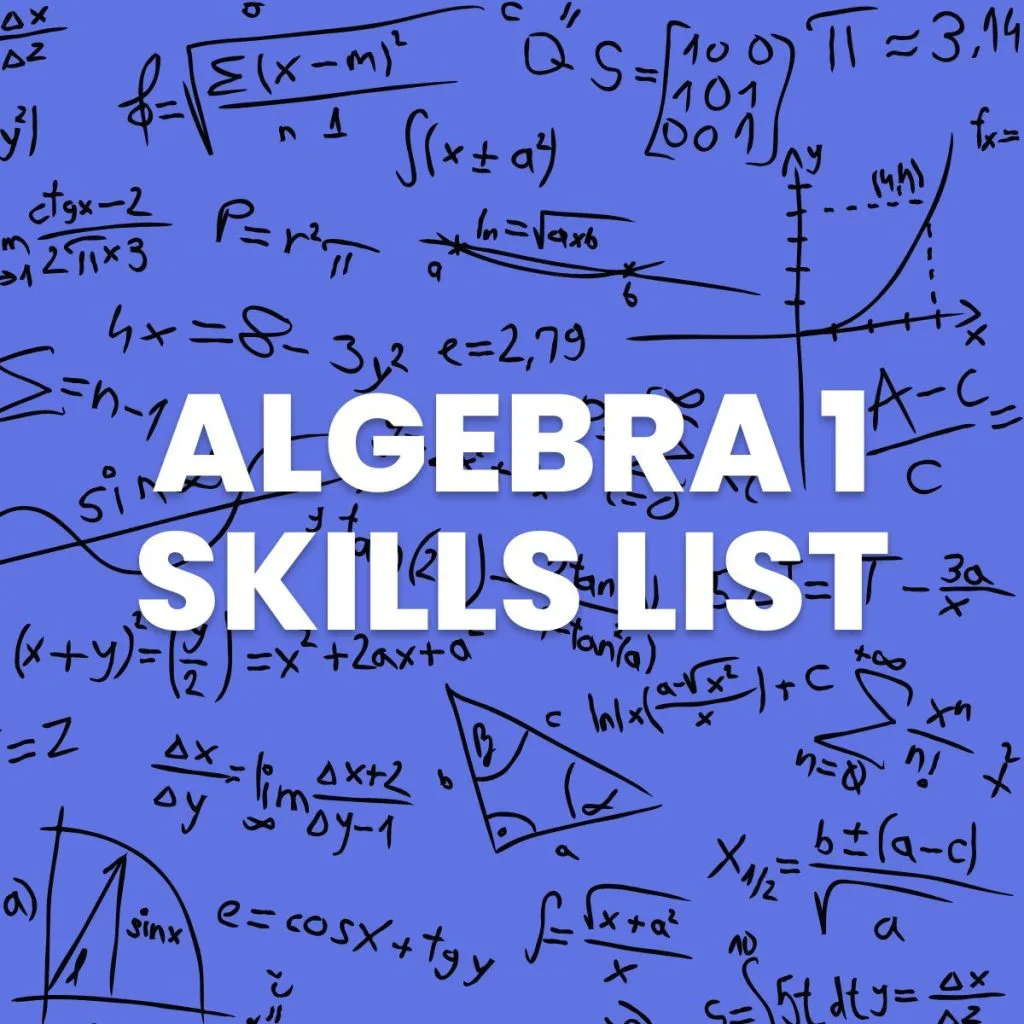
2017-2018 Algebra 1 SBG Skills List
The 2017-2018 school year was our second year using the Oklahoma Academic Standards which were written after Oklahoma adopted and then rejected Common Core. This set of skills reflects everything that I learned during my first year of teaching to the new standards.
After my first year of teaching to the new standards, I’ve figured out what worked and what utterly failed.
UNIT 1 – Expressions
- I can find the absolute value, opposite, reciprocal, and opposite reciprocal of a number.
- I can use the order of operations to simplify expressions.
- I can evaluate expressions. (A.3.4)
- Include Radicals
- Include Absolute Value Bars
- Include Fractions
- I can evaluate expressions involving non-standard operations. (A.3.4)
- I can rewrite expressions by combining like terms. (A.3.2)
- I can rewrite expressions by applying the distributive property. (A.3.2)
- I can translate between words and algebraic expressions, equations, and inequalities. (A.1.1, A.2.1)
UNIT 2 – Solving Equations and Inequalities
- I can solve equations and inequalities with variables on one side of the equal sign. (A.1.1)
- I can solve equations and inequalities with variables on both sides of the equal sign. (A.1.1)
- I can solve and graph compound inequalities on a number line. (A.2.2)
- I can solve absolute value equations. (A.1.2)
- I can solve absolute value inequalities. (A.2.2)
- I can solve an equation with many variables for one variable in terms of the others. (A.3.1)
UNIT 3 – Relations and Functions
- I can generate equivalent representations of a relation and determine if the relation is a function or not. (F.1.1)
- I can identify the independent and dependent variables in a situation. (F.1.2)
- I can find the domain and range of a function. (F.1.2)
- I can identify domain and range restrictions in real-life situations. (F.1.2)
- I can read and interpret the graph of a real-life situation. (F.1.4)
- Piecewise linear graphs – not step functions!
- Identify Independent and Dependent Variables
- Identify Domain and Range
- Identify Rate of Change
- I can create a graph to describe a story and create a story to describe a graph. (A.4.4)
- I can evaluate functions and interpret the results in real-life contexts. (F.3.2)
- I can write a function (using function notation) to model a real-world situation and use the function to answer questions. (F.1.3)
- I can determine if a function is linear or non-linear (quadratic, exponential or absolute value). (F.2.1, F.2.2)
- Emphasize Graphing by Making Input-Output Tables!
UNIT 4 – Linear Graphs and Inequalities
- I can calculate and interpret slopes and intercepts of a linear function. (A.4.1)
- I can classify equations as parallel, perpendicular, or neither. (A.4.2)
- I can write an equation (in slope-intercept, point-slope, and standard form) and use the equation to solve problems. (A.4.3)
- I can identify and generate equivalent representations of linear equations, graphs, tables, and real-world situations. (F.3.1)
- I can predict how a linear graph will be transformed when the equation is changed. (F.2.2)
- I can create scatterplots, determine regression and correlation, and use these to make predictions and assess the reliability of predictions. (D.1.2)
- I can graph a linear inequality and interpret the solution. (A.2.1)
- I can write a linear inequality and use the inequality to solve problems. (A.2.1)
UNIT 5 – Absolute Value Graphs and Inequalities
- I can find the slope, vertex, and orientation of an absolute value relation.
- I can write the equation or inequality for an absolute value relation.
- I can predict how the graph of an absolute value graph or inequality will be transformed when the equation or inequality is changed. (F.2.2)
UNIT 6 – Systems of Equations and Inequalities
(With each skill, have students determine how many solutions the system has!)
- I can solve systems of equations graphically and interpret the solution. (A.1.3)
- I can solve systems of equations using the substitution method. (A.1.3)
- I can solve systems of equations using the elimination method. (A.1.3)
- I can solve systems of inequalities and graph and interpret the solution on a coordinate plane. (A.2.3)
UNIT 7 – Polynomials
- I can name polynomials according to their degree and number of terms.
- I can write polynomials in standard form.
- I can add and subtract polynomials (including when written in function notation). (A.3.2, F.3.3)
- I can multiply polynomials (including when written in function notation). (A.3.2, F.3.3)
- I can factor out the GCF of a polynomial. (A.3.3)
- I can fully factor a polynomial. (A.3.3)
UNIT 8 – Radicals
- I can simplify radical expressions. (N.1.1)
- I can add and subtract radical expressions. (N.1.2)
- I can multiply radical expressions. (N.1.2)
- I can divide radical expressions, rationalizing the denominator when necessary. (N.1.2)
UNIT 9 – Sequences
- I can classify a sequence as arithmetic, geometric, Fibonacci, or neither and find the next term in the sequence.
- I can recognize that arithmetic sequences are linear and write a formula to find any term in the sequence. (A.3.5)
- I can recognize that geometric sequences are exponential and write a formula to find any term in the sequence. (A.3.6)
UNIT 10 – Data Analysis
- I can find the mean, median, mode, and range of a set of data.
- I can determine if a set of data is discrete or continuous. (D.1.3)
- I can create a data display for a set of data and use it to describe the data set. (D.1.1)
- I can interpret a data display.
- I can compare data sets using summary statistics. (D.1.1)
UNIT 11 – Probability
- I can determine the size of a sample space and use it to calculate probabilities. (D.2.1)
- Tree Diagrams
- Counting Procedures (Multiplication and Addition Principles)
- I can calculate experimental probabilities by performing experiments or simulations. (D.2.3)
- I can find complements, intersections, and unions using Venn Diagrams. (D.2.2)
- I can use Venn Diagrams to find the probability of an event (D.2.2).
- I can apply probability concepts to real-world situations to make informed decisions (D.2.4).
2016-2017 Algebra 1 SBG Skills List
The 2016-2017 school year was the first year that Oklahoma implemented their new academic standards for mathematics. As a result, I had to adapt my previous skills list to match the new standards.
In 2015-2016, my Algebra 1 course was made up of 8 units and 58 skills. To meet the new standards, I had to expand this to 12 units and 62 skills for the 2016-2017 school year.
The new standards require me to address simplifying and operating on radicals, arithmetic and geometric sequences, solving absolute value equations, systems of inequalities, and a much more in-depth look at probability.
Another big change I made was greatly reducing the “review” unit at the beginning of the year. I have decided to utilize my daily warm-up time to review these skills.
I also decided to combine several learning skills into a single learning skill. For example, I used to have evaluate functions from a table, evaluate functions from an equation, and evaluate functions from a graph as three separate skills.
For this school year, I combined them into a single skill of evaluating functions. I still teach them separately, but I chose to assess them together.
UNIT 1 – Fundamentals of Algebra
- I can evaluate linear, absolute value, rational, and radical expressions. (Includes Non-Standard Operations)
- I can rewrite expressions, equations, and inequalities by combining like terms.
- I can rewrite expressions, equations, and inequalities by applying the distributive property.
- I can translate between algebraic and written expressions, equations, and inequalities.
UNIT 2 – Solving Equations
- I can solve linear equations with variables on one side of the equal sign.
- I can solve linear equations with variables on both sides of the equal sign.
- I can solve absolute value equations.
- I can solve equations involving several variables for one variable in terms of the others.
- I can solve real-world problems by writing my own equation or using a given equation.
UNIT 3 – Relations and Functions
- I can create a story to describe a graph and create a graph to describe a story.
- I can generate equivalent representations of a relation.
- I can determine if a relation is a function or not a function and justify my answer.
- I can find the domain and range of a function and identify restrictions in real-life contexts.
- I can evaluate functions and interpret the results in real-life contexts.
- I can identify the independent and dependent variables in a situation.
UNIT 4 – Linear Graphs
- I can graph a linear equation by making an input/output table.
- I can calculate and interpret slope and intercepts from a graph.
- I can calculate and interpret slope and intercepts from a table or two points.
- I can calculate and interpret slope and intercepts from an equation.
- I can determine if a function is linear or non-linear. If the function is non-linear, I can determine if it is exponential.
- I can convert between slope-intercept, point-slope, and standard forms of equations.
- I can classify lines as parallel, perpendicular, or neither.
- I can predict how a graph of a linear function will be transformed when the equation is changed.
UNIT 5 – Writing Linear Equations
- I can write a linear equation given a graph and use the equation to solve problems.
- I can write a linear equation given the slope and a point on the line (including an intercept) and use the equation to solve problems.
- I can write a linear equation given a table or two points on the line (including intercepts) and use the equation to solve problems.
- I can write a linear equation given a situation and use the equation to solve problems.
- I can write a linear equation that is parallel or perpendicular to another equation and meets specific criteria.
UNIT 6 – Absolute Value Graphs
- I can graph an absolute value equation by making an input/output table.
- I can find the slopes, vertex, and orientation of an absolute value graph given a table.
- I can find the slopes, vertex, and orientation of an absolute value graph given an equation.
- I can write the equation of an absolute value graph given the slopes, vertex, and orientation.
- I can predict how an absolute value graph will be transformed when the equation is changed.
UNIT 7 – Inequalities
- I can represent a relationship with a simple one-variable inequality, solve the inequality, and graph and interpret the solution.
- I can represent relationships with a compound inequality, solve the inequality, and graph and interpret the solution.
- I can represent a relationship with an absolute value inequality, solve the inequality, and graph and interpret the solution.
- I can represent a relationship with a two-variable inequality, solve the inequality, and graph and interpret the solution.
UNIT 8 – Systems of Equations and Inequalities
- I can write a system of equations or inequalities to represent a given situation.
- I can solve systems of equations graphically and interpret the solution.
- I can solve systems of equations algebraically and interpret the solution.
- I can solve systems of inequalities and graph and interpret the solution on a coordinate plane.
UNIT 9 – Polynomials
- I can name polynomials according to their degree and number of terms.
- I can add and subtract polynomials (including when written in function notation).
- I can multiply polynomials (including when written in function notation).
- I can factor out the GCF of a polynomial.
- I can fully factor a polynomial.
UNIT 10 – Radicals (RA)
- I can simplify radical expressions.
- I can add and subtract radical expressions.
- I can multiply radical expressions.
- I can divide radical expressions, rationalizing the denominator when necessary.
UNIT 11 – Sequences
- I can classify a sequence as arithmetic, geometric, or neither and find the next term in the sequence.
- I can recognize that arithmetic sequences are linear and write an equation to find any term in the sequence.
- I can recognize that geometric sequences are exponential and write an equation to find the next term in the sequence.
UNIT 12 – Data Analysis and Probability
- I can determine if data is discrete or continuous.
- I can create a data display for a set of data and use it to describe the data set.
- I can compare data sets using summary statistics.
- I can create scatterplots, determine regression and correlation, and use these to make predictions and assess the reliability of the prediction.
- I can use tree diagrams and counting procedures to determine the size of a sample space and to calculate probabilities.
- I can use Venn Diagrams to evaluate probabilities.
- I can perform a simulation or experiment to calculate experimental probabilities.
- I can apply probability concepts to real-world situations to make informed decisions.
Free Download of 2016-2017 Algebra 1 SBG Skills List
My husband has been working on SBG skills for Geometry, so I asked him kindly for the template he was using to organize his units. I liked how he included both the new Oklahoma Academic Standards and the old PASS standards that each unit was aligned to. So, I did the same.
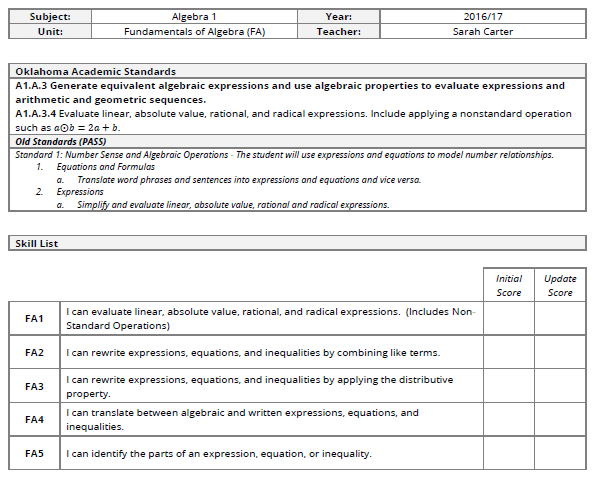
You can download this skills list below as either a PDF or WORD document.
2015-2016 Algebra 1 Skills List
2015-2016 was the last school year that Oklahoma used the OK PASS standards. I created my Algebra 1 skills list by taking all of the PASS standards for Algebra 1 and breaking them up into learning goals.
Then, I took all of the released end-of-instruction exam questions and sorted them by learning goal. After this, I identified the skills that I would need to review with my students for them to be successful.
Finally, I organized the learning goals into units. This ordering part was the most difficult for me. As a first year teacher, I tried to teach skills in the same order as the out-dated textbook presented them. I quickly found that the textbook order just did not make sense to me.
Since I didn’t use the textbooks and my district had no curriculum map or pacing calendar, the order I taught things in was entirely up to me. I both loved and hated this freedom at the same time.
For this school year, I had quite a few more goals than the previous year, but each goal had a much smaller scope. I hoped that this would help my students and I be able to clearly see our weak points and what we needed to work on.
Unit 1 – Algebra Fundamentals
- I can simplify numerical expressions involving integer operations.
- I can simplify numerical expressions involving fractions.
- I can simplify numerical expressions involving radicals.
- I can simplify algebraic expressions by combining like terms and using the distributive property.
- I can simplify algebraic expressions involving exponents.
- I can translate between written expressions and algebraic expressions.
- I can convert between units.
- I can graph points on the coordinate plane.
Unit 2 – Solving Equations and Word Problems
- I can solve equations with variables on one side of the equal sign.
- I can solve equations with variables on both sides of the equal sign.
- I can use equations to solve word problems.
- I can use ratios and proportions to solve word problems.
- I can solve word problems involving percentages.
- I can solve literal equations for a given variable.
Unit 3 – All About Functions
- I can identify whether a relation is a function or not a function and justify my answer.
- I can identify the domain and range of a function from a table or set of data points.
- I can identify the domain and range of a function from a graph.
- I can evaluate functions from an equation.
- I can evaluate functions from a table.
- I can evaluate functions from a graph.
- I can identify the independent and dependent variables in a situation.
Unit 4A – Linear Equations
- I can determine slope and intercepts from a graph.
- I can determine slope and intercepts from a table or two points.
- I can determine slope and intercepts from an equation.
- I can determine if a function is linear or non-linear.
- I can graph linear equations.
- I can identify which ordered pairs are solutions to a given equation.
- I can predict how a graph will change when the slope or intercepts are changed.
Unit 4B – Linear Equations
- I can write a linear equation given a graph.
- I can write a linear equation given a scenario.
- I can write a linear equation given the slope and an intercept.
- I can write a linear equation given the slope and a point on the line.
- I can write a linear equation given a table or two points on the line.
- I can write a linear equation given the x-intercept and y-intercept.
- I can interpret the meaning of the slope and intercepts in a situation.
- I can classify two lines as parallel, perpendicular, or neither.
Unit 5 – Systems of Equations
- I can write a system of equations to match a given scenario.
- I can solve systems of equations graphically.
- I can solve systems of equations algebraically.
Unit 6 – Inequalities and Absolute Value
- I can verify if a number is a solution to an inequality.
- I can solve simple one variable inequalities and graph the solution.
- I can solve complex one variable inequalities and graph the solution.
- I can graph two variable inequalities.
- I can verify if an ordered pair is a solution to an inequality.
- I can graph absolute value equations.
- I can predict how changing an absolute value equation will change its graph.
Unit 7 – Polynomials
- I can name polynomials according to their order and number of terms.
- I can add and subtract polynomials.
- I can multiply polynomials.
- I can factor out the GCF of a polynomial.
- I can factor quadratic binomials and trinomials, if possible.
Unit 8 – Data Analysis and Probability
- I can choose an appropriate representation for a set of data.
- I can read graphs and make predictions.
- I can solve problems involving measures of central tendency.
- I can identify the type of correlation of a scatter plot.
- I can choose an appropriate line of best fit for a scatter plot.
- I can make predictions using a scatter plot and line of best fit.
- I can solve problems involving probability.
2014-2015 Algebra 1 Skills List
2014-2015 was my first year implementing SBG (standards-based grading) in all of my classes. During the 2013-2014 school year, I trialed SBG for part of the year with my Algebra 2 classes.
I write the skills lists for all three of my preps over the course of about a day and a half. I know that I benefited looking at other people’s learning goals online, so I hope that my list helps someone out.
Unit 1 – Relations and Functions
- I can label the parts of the coordinate plane.
- I can correctly graph ordered pairs.
- I can represent a relation four different ways.
- I can classify a relation as a function/not a function and justify my answer.
- I can classify variables as independent and dependent.
- I can evaluate a function using tables, equations, or graphs.
- I can graph a function on the coordinate plane.
Unit 2 – Linear Functions
- I can identify the four types of slope.
- I can find the rate of change given a graph, a table, or a set of points and interpret its meaning.
- I can classify a set of data as linear/non-linear and justify my answer.
- I can identify the slope, x-intercept, and y-intercept from a graph, table, equation, or set of points.
- I can graph horizontal and vertical lines and recognize their equations.
- I can develop the equation of a line given slope and y-intercept, slope and one point on the line, two points on the line, x-intercept and y-intercept, or a set of data points.
- I can rewrite a linear function in a given form.
- I can construct lines that are parallel, perpendicular, or neither parallel nor perpendicular to a given line.
Unit 3 – Inequalities and Systems of Equations
- I can solve a system of linear equations by graphing.
- I can solve a system of linear equations by elimination.
- I can solve and graph simple inequalities in one variable.
- I can solve and graph compound inequalities in one variable.
- I can graph and interpret the solution of inequalities in two variables.
Unit 4 – Polynomials and Expressions
- I can name polynomials according to their degrees and numbers of terms.
- I can use exponent rules to simplify expressions.
- I can add, subtract, and multiply polynomials.
- I can factor the GCF out of a polynomial.
- I can factor quadratic trinomials.
- I can simplify rational expressions.
Unit 5 – Absolute Value Functions
- I can define absolute value and identify the absolute value of a number.
- I can evaluate expressions involving absolute value.
- I can graph absolute value functions.
- I can predict the effects of transformations on the absolute value parent graph.
Unit 6 – Radical Expressions
- I can simplify radicals.
- I can add and subtract radicals.
- I can multiply radicals.
- I can rationalize the denominator of a fraction.
Unit 7 – Algebraic Problem Solving
- I can translate between written expressions and algebraic expressions.
- I can solve linear equations for x.
- I can solve literal equations for a given variable.
- I can use algebra to solve problems.

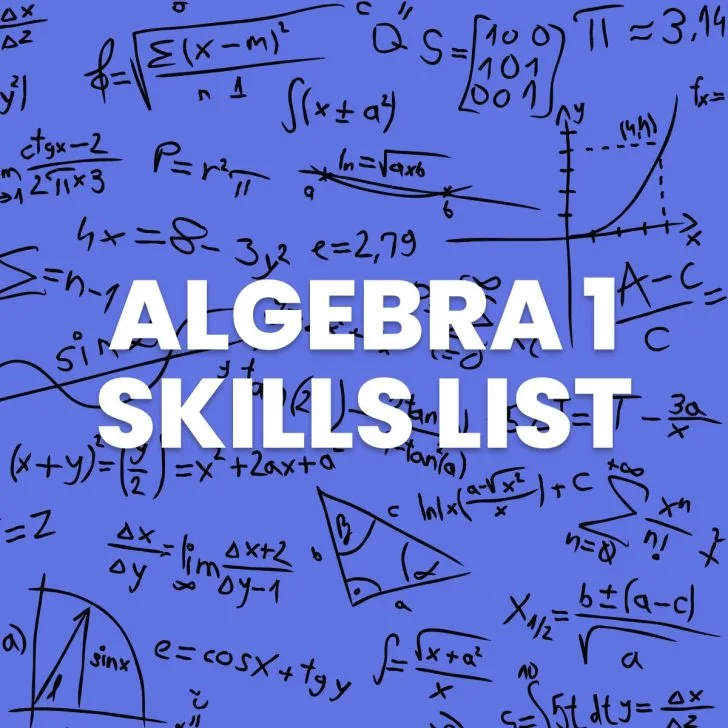
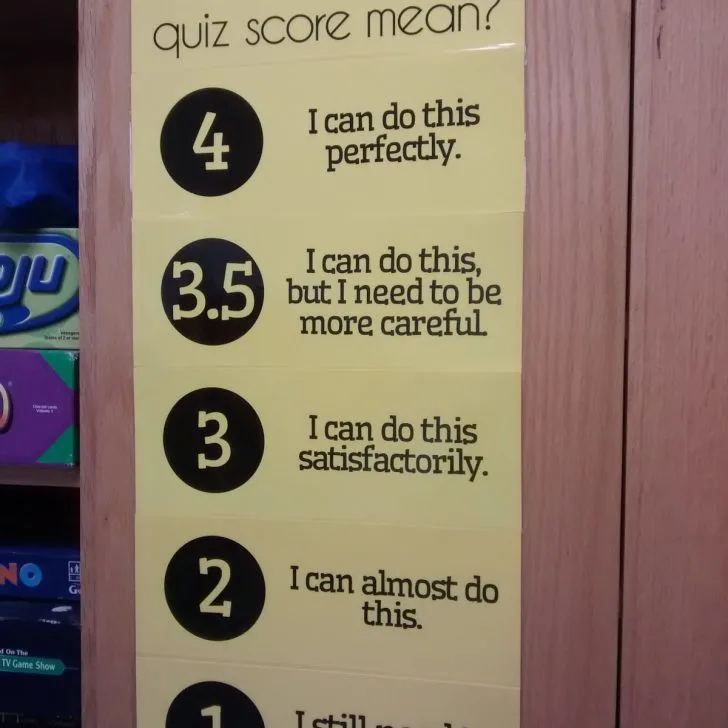
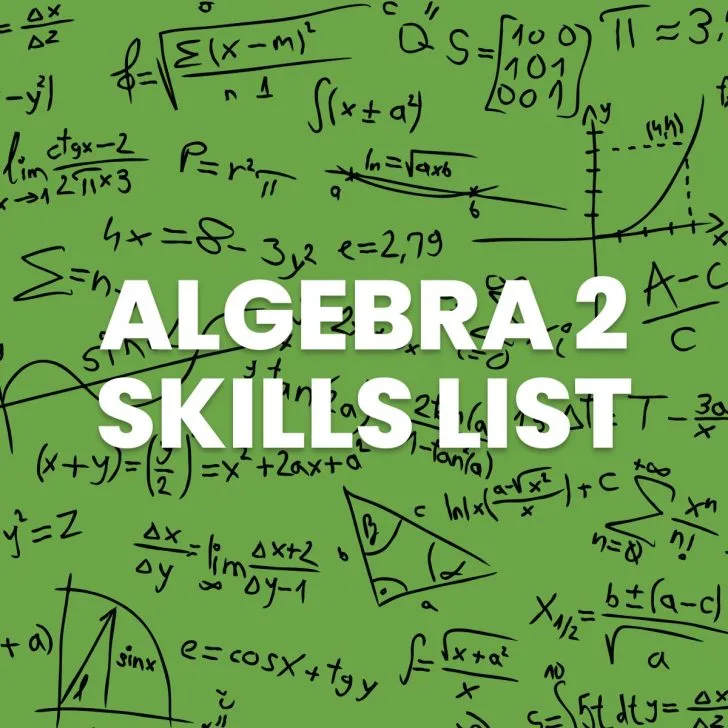
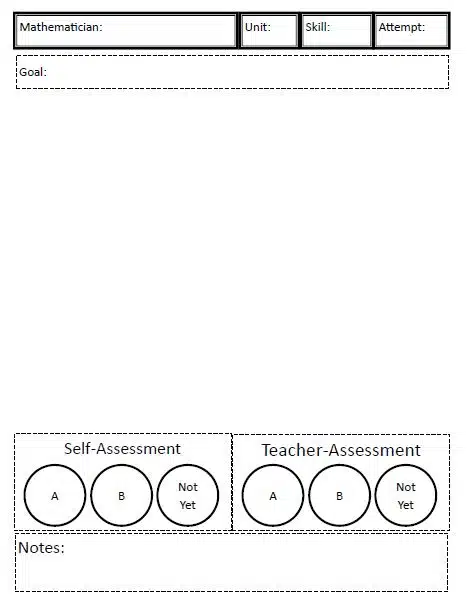
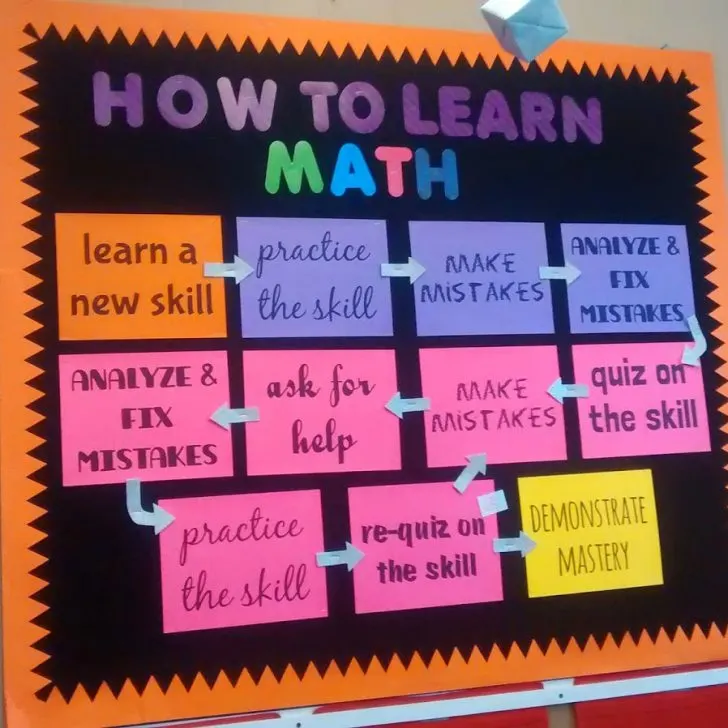
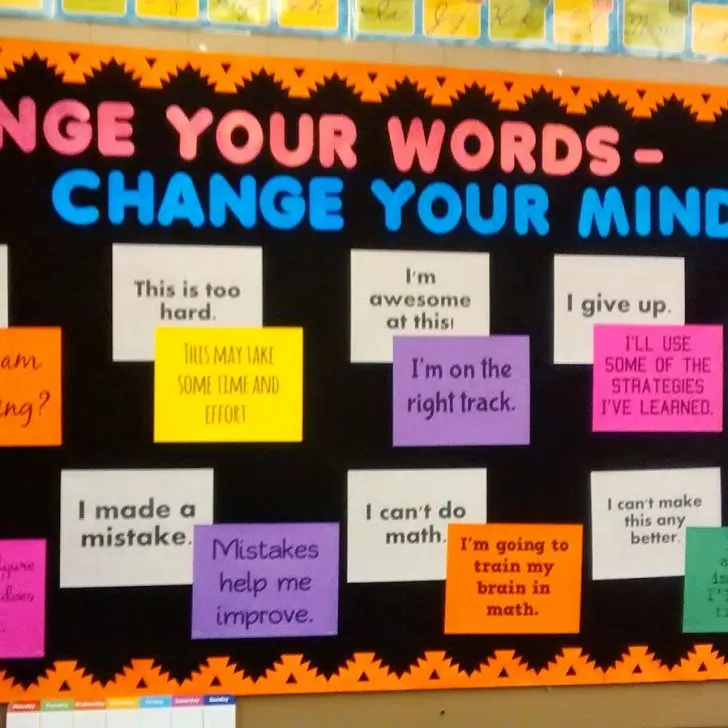
Kathi Trujillo
Friday 7th of January 2022
I LOVE YOU! This list has been so helpful as our school moves into SBG (without any training specific to math). You have saved me hours of work and now I just need to write my rubrics and prepare materials for next year.
Your blog is the best ever for improving my math teaching!
Unknown
Thursday 24th of August 2017
Do you have notebook dividers for these new units yet? We started school a couple of weeks ago, so we have started Unit 1 in our IMNs. It is really interesting that the changes I made your divider from last year is very much like your new Expressions unit. I just called it Algebra Basics and included The Real Number System since we are still CCSS and have to do Rational vs. Irrational classification and the Closure Property.